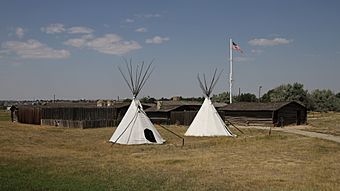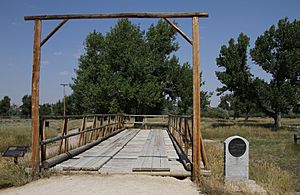Fort Caspar facts for kids
Quick facts for kids |
|
|
Fort Caspar and Boundary Increase
|
|

Reconstructed buildings at the site of Fort Caspar
|
|
| Location | 14 Fort Caspar Rd. Casper, Wyoming 82604 |
|---|---|
| Architect | Louis Guinard |
| NRHP reference No. | 71000887; 76002282 |
| Added to NRHP | August 12, 1971; July 19, 1976 |
Fort Caspar was an important military base for the United States Army in what is now Wyoming. It was named after a brave young officer, 2nd Lieutenant Caspar Collins. He was killed in a battle in 1865 against the Lakota and Cheyenne tribes.
The fort started in 1859 as a trading post and a bridge on the Oregon Trail. It was built along the North Platte River. The Army later took it over and called it Platte Bridge Station. Its job was to protect people traveling west and the telegraph lines. This was important during conflicts between the United States and Native American tribes.
Today, the fort's site is in Casper, Wyoming. It is listed on the National Register of Historic Places. The City of Casper now runs it as the Fort Caspar Museum and Historic Site.
Contents
History of Fort Caspar
The area around Platte Bridge Station was used by the Army for many years. It was a place where the Emigrant Trail crossed the North Platte River. In 1847, during the first Mormon journey to Utah, Brigham Young set up a ferry here. This ferry helped people cross the river.
Mormon groups returned each summer until 1852 to run the ferry. It was later replaced by a rope-and-pulley system. This new system could cross the river in just five minutes.
Early Trading Posts and Bridges
In later years, a trader named John Baptiste Richard built a trading post. The U.S. Army set up its first presence nearby in 1855. They built Fort Clay close to Richard's post.
In 1859, Louis Guinard built a bridge at the old Mormon Ferry crossing. This bridge was called the Platte Bridge Station. From 1860 to 1861, the Pony Express used this site as a station.
Army Presence and Conflicts
By the mid-1860s, more settlers were moving into the region. This caused problems with the Lakota and Cheyenne tribes. To protect the new telegraph line and settlers, the Army increased its presence.
In 1861, soldiers were sent to guard Guinard's bridge. Many of these troops were from state units formed during the Civil War. In 1862, the Army used the buildings at Platte Bridge Station. They also built and occupied Fort Caspar.
Louis Guinard, who built the bridge, drowned in 1865. His nephew, Louis P. Guinard, took over the property. The bridge was later destroyed by Native Americans after the troops left in 1865.
Battle of the Platte Bridge Station
In July 1865, thousands of Cheyenne and Sioux warriors approached Platte Bridge Station. They planned to attack the soldiers and destroy the bridge. They had scouted the area and knew the soldiers were camped in tents, not inside the fort's wooden walls.
On July 25, a large group of warriors drove off some horses. They forced the soldiers to use a lot of their ammunition. The station had permanent buildings by then. A mountain howitzer (a type of cannon) covered the bridge.
Late that night, a group of soldiers arrived from Sweetwater Station. They were on their way to Fort Laramie for supplies. They found the station on high alert. The officers discussed sending a relief force to help a wagon train that was due to arrive.
Second Lieutenant Caspar W. Collins, only 20 years old, was ordered to lead the relief. He borrowed pistols and rode out. Among the Native American leaders were Red Cloud and the famous warrior Roman Nose. George Bent, who was half Cheyenne, also fought in the battle.
At dawn, many warriors were seen on the hills around the station. At 7:00 a.m., a large force crossed the river. They rode just out of rifle range, trying to provoke the soldiers. Collins and 25 men crossed the Platte Bridge. They rode west to drive off any hostile warriors.
Behind them, other soldiers crossed the bridge on foot. They formed a line when they saw hundreds of Cheyenne appear. The Native Americans had hidden large groups of warriors near the bridge. There might have been as many as a thousand Lakota, Cheyenne, and Arapaho.
Collins charged the first group, but he was greatly outnumbered. He ordered a retreat back to the bridge. Another force of Lakota tried to rush the bridge. The soldiers at the bridge held them back with gunfire.
Twenty of the 26 troopers fought their way back, all wounded. Five were killed, including Collins. He was shot with an arrow while trying to help a wounded soldier. The battle lasted only a few minutes.
Later that morning, the attacking force destroyed a thousand feet of telegraph wire. The wagon train, led by Sergeant Amos J. Custard, was attacked about five miles west of the station. The wagons were forced into a hollow. They fought for four hours until a large group of warriors overwhelmed them. All the defenders were killed.
The wagons were burned around 3:00 p.m. Two scouts were sent to get help, but the attacking force broke up before reinforcements arrived.
This battle became known as the Battle of Platte Bridge Station. The attack on the wagon train was also called the Battle of Red Buttes. In total, 27 soldiers and Lt. Collins were killed. The Army officially renamed the post Fort Caspar to honor Collins.
Abandonment of the Fort
The fort was abandoned two years later in August 1867. The soldiers moved to Fort Fetterman in Douglas, Wyoming.
Fort Caspar Museum Today
Fort Caspar was partly rebuilt in 1936. The reconstruction used drawings made by Lieutenant Collins in 1863. The fort changed a lot over time, and the current recreation shows what it looked like from 1863 to 1865.
The City of Casper now runs a museum at the site. It has reconstructed log buildings and a wooden stockade. You can also see a copy of the Mormon ferry that operated there. There is also a model of part of the bridge that replaced the ferry. In early December, a living history group performs historical reenactments at the site.


